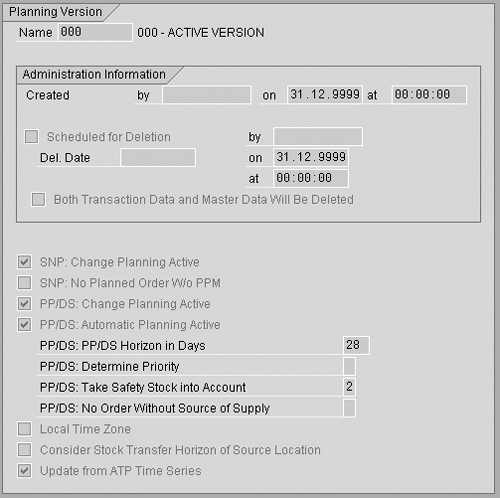Subtle differences in the way SAP APO SNP and the Production Planning and Detailed Scheduling (PP/DS) applications calculate safety stock are often a source of confusion. Gain an understanding of these differences and see how you use the SAP safety stock methods in PP/DS.
In most cases, the safety stock calculation methods in the SAP
APO SNP and Production Planning and Detailed Scheduling (PP/DS)
applications operate in the same way. However, subtle differences
exist in the way the planned safety stock is displayed and in the
calculation of the safety stock values. This is a source of confusion
when calculating safety stock in PP/DS that I would like to clear
up.
Safety stocks in SNP are always displayed as a quantity. This
applies directly when you use quantity-based safety stock methods
(SB, MB, AS, AT, BS, and BT). For demand-based
safety stock methods (SZ and MZ),
a macro translates the required safety days' supply into quantities
before viewing them in the SNP Interactive Planning transaction.
The same applies to the quantity-and-demand-based safety stock methods
(SM and MM). Earlier articles
in this series on safety stock planning describe these safety stock
methods in detail.
The display of safety stock values within PP/DS — for example,
in the Product View transaction (menu path Production
Planning>Interactive Production Planning> Product View,
or transaction code RRP3) — is not always
this easy to understand. The quantity-based safety stock method
results are displayed in the transaction as requirement quantities,
just like any other order, while the demand-based safety stock methods
do not create any entry at all. The quantity-and-demand-based safety
stock methods create a requirement entry reflecting only the quantity-based
safety stock portion of the total safety stock requirement. The
available safety stock methods for PP/DS are also driven by the
settings in the Lot Size tab on the Product
Master screen.
I will explain the PP/DS functionality while highlighting the
differences between PP/DS and SNP by each safety stock method. I
will then look at common PP/DS-specific safety stock issues. The
following information applies to APO 3.0 SP26, APO 3.1 SP17, and
APO 4.0 SP04.
The static (time-independent) safety stock methods in APO
(SB,
SZ, and SM) can be used only after
the usage of safety stock definitions has been activated for a given
planning version (menu path Master Data>Planning Version
Management>Model and Version Management, or transaction
code MVM). As Figure 1 shows,
select your planning version and set the value of the field PP/DS
Take Safety Stock into Account to 1 if
you use only static safety stock methods, or otherwise to
2.

Figure 1
Set the safety stock definitions for the planning version
Now let's look at how the safety stock methods work within
PP/DS.
Static Safety Stock Methods
SB: With this method, a requirement with the
available-to-promise (ATP) category CB is created
at the beginning of the planning horizon (i.e., the current date
and time). This safety stock requirement can be viewed, for example,
in the Product View transaction and is accommodated
by the PP/DS planning just like any other requirement. Changes in
the product master safety stock settings are immediately reflected
in the product's planning situation.
SZ: No specific safety stock entry can be seen
in the Product View transaction with this method.
The Safety Days' Supply setting of the Product
Master is used as a time offset that determines how many
days earlier the receipt element must be created in relation to
the demand. Because demands are matched with early supply elements,
a safety stock is built up. In most cases, the calculations carried
out in PP/DS provide a similar build-up of safety stocks as those
calculated within SNP. You need to watch out for a few points, though.
PP/DS moves all supply elements (e.g., planned orders) in accordance
with the Safety Days' Supply setting. These
supply elements normally cover the same demand elements used in
the SNP macro calculation. The standard SNP macro uses the Total
Demand key figure, but this might have been changed to
consider only part of the demand. In this case, the SNP-calculated
safety stock is lower than that calculated by PP/DS.
While offsetting the supply element in accordance with the Safety
Days' Supply value, PP/DS uses the production calendar
from the location master. When using the standard-delivered macro
for the SNP safety stock calculation, the shipment calendar of the
location master is used. In cases where the production and the shipment
calendars use different definitions for the working days, additional
discrepancies between SNP and PP/DS might occur.
SM: This method combines both procedures as explained
above. A safety stock requirement with the ATP category CB
is created and, additionally, demand is satisfied early. Note that
this approach is different than the one used in SNP where the higher
of the two results determines the safety stock. Using this method,
PP/DS first creates a safety stock requirement and then shifts all
supply elements, even the one to satisfy the safety stock requirement,
by the period as defined in the Safety Days' Supply
value.
Dynamic Safety Stock Methods
Before dynamic (time-dependent) safety stock methods (MB,
MZ, and MM) can be used in PP/DS, you
must do some customization on the system. The key figures
SAFETY
(for dynamic quantity-based safety stock methods) and SVTETY
(for dynamic demand-based safety stock methods) are linked to the
functions Safety Stock and Safety Days'
Supply. You must use the same planning area in these definitions
as the one defined in the global PP/DS parameters.
Open the APO customization (transaction SPRO)
and follow the menu path SAP Advanced Planner and Optimizer>Supply
Chain Planning>Production Planning and Detailed Scheduling>Make
SNP Key Figures Available. Carry out steps 1 through 3
below if you use the dynamic safety stock methods MB
or MM or any extended safety stock method.
Step 1. Select the New Entries
button and select your SNP planning area and the planning object
structure 9AMALO. This is mandatory; do not use
any other planning object structure.
Step 2. Type in the SNP key figure in which the
safety stock values are defined. This is usually the key figure
SAFETY (Safety Stock (planned)) and not
SAFTY (Safety Stock). Note that these key figures
are not displayed as a possible entry!
Step 3. Select the function Safety Stock and
save the settings.
Carry out the additional steps 4 through 6 if you use the dynamic
safety stock methods MZ or MM.
Step 4. Select the New Entries
button and select your SNP planning area and the planning object
structure 9AMALO. This is mandatory; do not use
any other planning object structure.
Step 5. Type in the SNP key figure in which the
Safety Days' Supply values are defined. This
is usually the key figure SVTETY (Safety Days' Supply
(planned)). Note that the key figure is not displayed as
a possible entry!
Step 6. Select the function Safety Days'
Supply from the top of the list and save the settings.
Your screen should now look like Figure 2. The
special considerations for using dynamic safety stock methods in
PP/DS follow:

Figure 2
You should see a screen similar to this one once you successfully customize APO PP/DS to use dynamic safety stock settings
MB: With this method, a requirement with the
ATP category CB is created at the beginning of
the planning horizon. PP/DS uses an SNP key figure (see the customization
steps on page 9). As a result, the same safety stock value seen
within SNP for the first day can also be seen in PP/DS for that
particular day. PP/DS then calculates the difference in required
safety stock per day. In the case of increasing safety stock requirements,
a delta requirement with the ATP category CB and
a negative value is automatically created by the system to indicate
the higher safety stock requirement. In the case of decreasing safety
stock requirements, a delta requirement with the ATP category
CB
and a positive value is created to indicate the lower safety stock
requirement. Thus, the safety stock requirement becomes a virtual
safety stock receipt
Note
All APO systems before Release 3.0 SP23 and Release 3.1 SP12
use a different approach, so the methods described here do not
apply.
MZ:SZSZSafety Days' SupplyMZSafety
Days' SupplySVTETYSZ MM: This method combines methods MB
and MZ. A safety stock requirement is created per
day and all demand in addition to the safety stock requirement is
satisfied early. Note that this approach differs from the one used
in SNP where the higher of the two results determines the safety
stock.
The usage of extended safety stock methods requires the same setup
as method MB. In technical terms, there is no difference
between method MB and the extended safety stock
methods in PP/DS. PP/DS reads an SNP key figure to determine the
dynamically changing safety stock requirements in both cases.
PP/DS Heuristics
Note that the selected PP/DS heuristic, with its embedded net
requirements calculation, determines whether or not the safety stock
settings are used. Some heuristics use the safety stock settings,
others don't. Table 1 provides an overview
of the standard delivered PP/DS heuristics.
| Heuristic Algorithm |
Safety Stock Definitions Used? |
| HEU_PLAN_STANDARDLOTS |
Yes |
| HEU_PLAN_DEFICITS |
Yes |
| HEU_PEGID_PERIODIC_LOT |
Yes |
| HEU_PART_PERIOD |
Yes |
| HEU_PUR_PLANNING |
No |
| HEU_REORDER_POINT_PLAN |
No |
| HEU_PLAN_STDLOTS_CONTI |
Yes |
| |
| Table 1 |
PP/DS heuristics and safety stock
definitions |
For further information, check the individual PP/DS heuristics
description. Open the APO customization (transaction SPRO)
and follow the menu path SAP Advanced Planner and Optimizer>Supply
Chain Planning>Production Planning and Detailed
Scheduling>Heuristics>Maintain
Heuristics. Select the Information button
to obtain further information on the PP/DS heuristic.
Safety Stock and Shelf-Life Planning
When using the PP/DS heuristic HEU_PLAN_STANDARDLOTS
and planning in accordance with the product's shelf life,
no dynamic quantity-based or extended safety stock methods should
be used. The problem is that delta safety stock requirements with
a positive value (such depicting a reduced safety stock requirement)
cannot have a remaining shelf life and thus cannot be used to satisfy
any demand. The PP/DS run does not create any warning or error,
but the planning result is not usable.
Safety Stock and Pegging
The pegging functionality in APO is a powerful but sometimes difficult-to-
understand
tool. The pegging algorithm links, or pegs, supply with demand elements
that exist in the liveCache. Safety stock requirements, which are
created when using safety stock methods other than SZ
and MZ, are not modeled as requirements in the
liveCache and can therefore not be seen by the pegging algorithm.
This has positive and negative implications:
- The safety stock requirement is seen by the net requirements
calculation, and a receipt covering this requirement is calculated.
This receipt is seen by the pegging algorithm, but the corresponding
safety stock requirement is not, since it is not modeled in liveCache.
As a consequence, an unwanted alert indicating overcoverage is
generated. It is possible to disable this alert, but then no alerts
are generated even in the most peculiar overcoverage situation.
Using the pegging strategy FIFO (first in, first out) with an
adequate setting for the maximum earliness of the receipt usually
results in the alert being generated toward the end of the PP/DS
horizon. It is then easy to not display such alerts that are generated
for the end of the PP/DS horizon.
A similar false overcoverage situation (and workaround solution)
exists when demand-based safety stock methods are used. In this
case, the supply elements are created in such a way that they
cover known demand too early for the pegging algorithm.
- An overcoverage situation exists for the pegging algorithm when
safety stocks are defined. Consequently, the pegging algorithm
creates undercoverage alerts only after the perceived overcoverage
is used up. This is a wanted behavior, as it successfully avoids
the creation of alerts as long as a demand can be satisfied through
the reduction of safety stock.
- APO also offers the possibility to create safety stock orders
directly in liveCache. These safety stock orders, which constitute
requirements, are planned for by the net requirements calculation,
and they are also seen by the pegging algorithm, so no unwanted
alerts are created. The problem with this solution is that any
safety stock usage triggers a safety stock shortage alert. This
is in most cases undesired, as the usage of safety stock is normal
in the short term. Also note that this option works only in conjunction
with safety stocks defined in the product master and not with
dynamic safety stocks. The creation of safety stock orders in
liveCache using a special report is described in SAP notes 374624
and 578839.

Wolfgang Eddigehausen
Wolfgang Eddigehausen is a highly experienced expert in the areas of business process design, re-engineering, and user adaption, as well as process realization in complex SAP-centric environments. He has experience in solution and enterprise architecture and project management (PRINCE2 certified) domains defining enterprise capabilities with a focus on delivering effective and efficient solutions to organizations. Wolfgang's industry knowledge includes public sector, utilities, mining, distribution, general manufacturing, process and steel industries, and consumer goods.
In most roles his task is not only to architect a solution but also to evaluate and define strategic options with a focus on end-to-end solutions rather than systems. This also includes strong emphasis on the user acceptance through an innovative user experience and mobility enablement.
His career includes successful participation and management of projects in Australia, Europe, India, Japan, Singapore, South Africa, Taiwan, and the US. These projects required interaction with all levels of an organization, from the shop floor or office through to the CxO level. Throughout his career, Wolfgang has put emphasis on a holistic approach bringing together people, processes, information, and systems in project management, architecture, and implementation roles.
You may contact the author at we@avox.com.au.
If you have comments about this article or publication, or would like to submit an article idea, please contact the editor.









